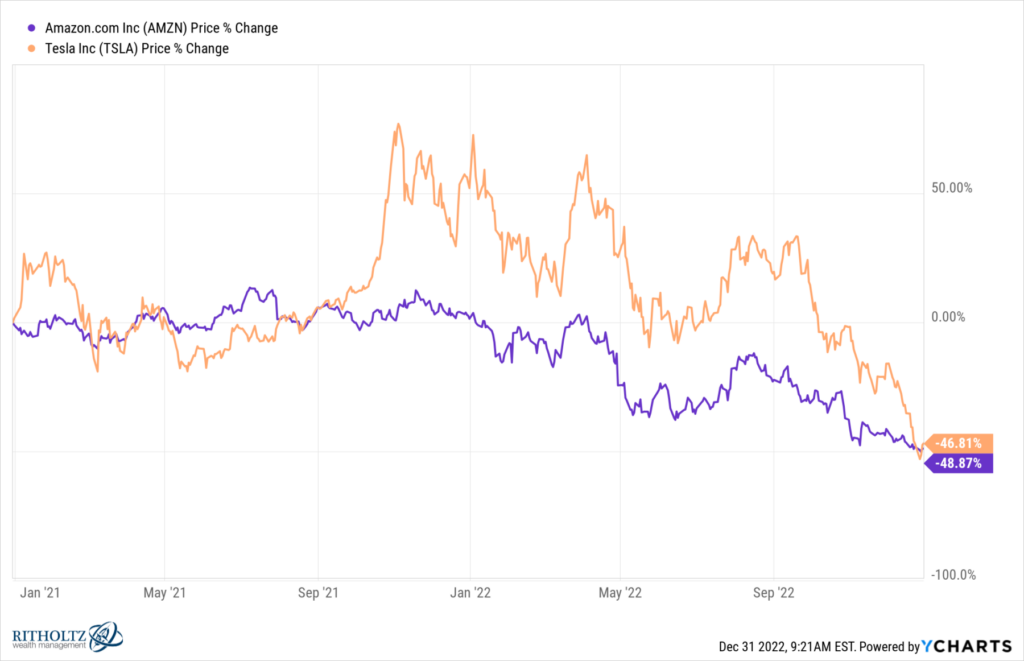Welcome to 2023!
Let’s jump into the new year with some fresh observations, some of which are quite surprising:
• Astronomical Measures of Time Are Unrelated to Investing: It takes the Earth 365 days, 6 hours, 9 minutes, and 9.76 seconds to complete one orbit – to return to its exact same place in space relative to our star, the sun. Our planet has done this about 4.54 billion times.1
What does this rock traversing through the vast emptiness of space have to do with economic expansion, corporate revenues & profits, inflation, or interest rates?
Alas, utterly nothing.
It is natural to hope the flipping of the calendar brings something new and different. But why? Holding onto expectations of major shifts in key drivers of the markets and the economy – merely due to the changing of the calendar – is a carryover from the days when the calendar mattered much more. The change of seasons mattered a great deal to hunter-gatherers and farmers; they matter far less to those charged with putting capital at risk in markets.
If you must think in terms of a year, try thinking in a series of rolling 12-month periods. It’s still a year, but it’s freed from irrelevant cosmological trappings of the annual calendar.
• Mean Reversion is overlooked: A decade of returns nearly double historical averages must eventually return to more supportable levels of growth. 2022 can be understood as part of that process.
Consider: From 2010 through 2021, The S&P500 Index gained 330% — a little over 13% annually (not including dividends). Historically, SPX averages about 8% with dividends.
We can credit three elements for this massive outperformance:
-Substantial prices resets: 57% in 2008-09 and 34% in 2020
-Monetary stimulus (ZIRP/QE) from 2009-2021
-Fiscal stimulus 2020-22
The resets are now history, monetary stimulus is no more, but we still have CAREs Act, the Inflation Reduction Act, and the Infrastructure bill coursing through a still healthy economy. Given all that, perhaps the 20% equity drawdown is less significant than many believe.
• March Magic or March Madness? Here’s a fun set of coincidences from an admittedly small data set: Over the past few decades, all of the major bear markets found a bottom in the month of March.
–Dot Com Implosion, March 2003: After making a provisional low in October 2002, the dot com collapse reached its nadir in March 2003 coinciding with the launch of the Iraq invasion by the United States. The rally from those lows were close to a market double by the time we saw the next peak in October 2007.
–Great Financial Crisis, March 2009: The S&P 500 index made a generational low post-GFC on March 9, 2009, after having fallen 56.78%. The next ~12 years saw gains of 608.5% through January 4, 2022.
–Covid Pandemic Crash, March 2020: Fast and furious, it took a mere 22 trading days from February 19 to March 20 to see a fall of 33.9% until markets began bouncing back on March 23, 2020. From those lows, markets gained 68% by 2020’s year-end and another 28% in the following calendar year.
Might 2023 be a fourth major March bottom? It looks like an amusing coincidence, but it could happen: Imagine the Fed continues to tighten monetary conditions as the economy slows, consumers pull back, housing gets even worse, and job creation falters. What could follow is a grind lower until the end of Q1.
The caveat: “March bottoms” are a tiny sample set, and more likely a coincidence than anything meaningful.
Still…
• Acting on Predictions: Every year around this time, endless forecasts fill the media. But here is the unexpected thing about those predictions: Even if your forecast of future events is correct, the odds are against you capturing it in your portfolio.
See for an example: WSJ: Wall Street Nailed Earnings but Missed the Bear Market
“The FactSet consensus prediction is for $221 a share this year, exactly as predicted, with the final quarter still based on estimates . . . Their success is rather spoiled by Wall Street’s total failure to anticipate the bear market in stocks and bonds.”
What’s already priced in? What does the timing look like? What second-level effects are there?
Even if you could forecast future earnings and economic data, it is far less helpful to your portfolio than you imagine.
• Tesla Had a Bad Year; Amazon had a Worse 2 Years: I love finding odd correlations and comparisons, and this one seems to really pack a surprise.
For sure, 2022 was a rough year for Elon Musk: He was forced to buy Twitter for $44B, then watched Tesla lose 70% of its market cap. His net worth fell by $200 billion dollars, something that has never happened to anyone before (at least, not on a nominal basis).
But Tesla’s annus horribilis followed a strong 2021 at +49.8%. Amazon also had a bad 2022, but it was not as fortunate as Tesla was in 2021: In a year where the S&P500 gained 28%, Amazon was ~flat at +2.4%. I first noticed this about a year ago (2021’s Surprising Laggard: Amazon) and have been paying attention ever since.
The surprising data point: Tesla fell 46.8% over 2021-22, but Amazon dropped more, losing 48.9% of its value.
Too bad my firm does not short stocks, as both of these were big downside winners…
Beware of Value Traps: Be careful picking through 2022’s refuse-hunting for a bargain. With this many stocks shellacked, temptations abound. But before pulling the trigger on a former high-flyer, be aware of the reasons it is no longer flying high.
Always remember this quote, credited to David Einhorn (but perhaps older) that observes:
“What do you call a stock that’s down 90%? A stock that was down 80% and then got cut in half.” -David Einhorn
Just because a stock is down big does not mean that it cannot go lower…
~~~
Have a great 2023 – embrace risk, but avoid unforced errors.
Previously:
2021’s Surprising Laggard: Amazon (January 5, 2022)
What’s Ailing Tesla’s Stock? (October 17, 2022)
___________
1. When the earth first formed, a day was a mere 4 hours. Estimates are that 3 billion years or so ago, a day was only 12 hours. 2 billion years ago it was 18 hours.
Also of note: A galactic year is the time required for the Sun to orbit around the Milky Way Galaxy –about 230 million earth years. That is not relevant to anything we are discussing, but still, it’s a fascinating measure…



